Exploring Malachite Stone: Insights and Artistry on Etsy
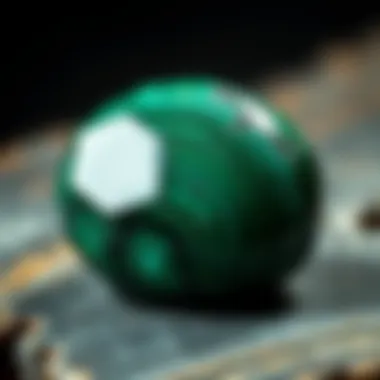
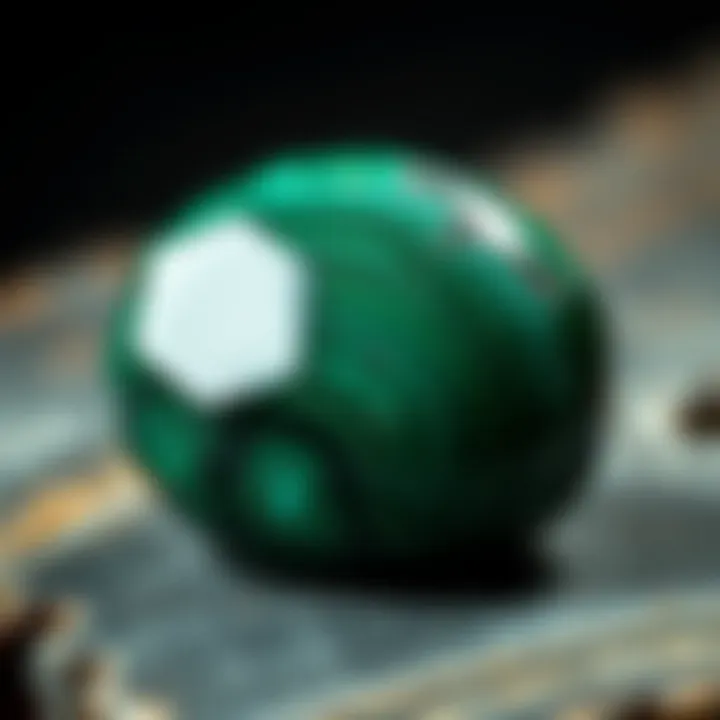
Intro
Malachite has fascinated collectors and artisans alike for centuries. Its vibrant green hue and swirling patterns draw the eye, making it a sought-after material for both jewelry and decor. In the digital marketplace, Etsy stands as a beacon for those looking to tap into this earthy gemstone's charm. Not only does it provide a platform for artisans to showcase their unique creations, but it also serves as a hub for enthusiasts eager to discover the many facets of malachite. This article will embark on a detailed journey through the history, characteristics, and artistry surrounding malachite, highlighting what sets it apart in the world of collectibles.
History and Origins
Malachite’s story goes back thousands of years, deeply ingrained in ancient cultures from Egypt to Mesopotamia. This stone was often associated with transformation and protection, playing a role in jewelry and ornamental arts. Ancient Egyptians, for instance, believed that malachite held the power to ward off evil spirits, often crafting it into amulets or using it in burials. Over time, malachite became a prized material, referenced in historical texts not just for its beauty, but also for its supposed power.
Overview of Collectibles, Rocks, and Fossils
In the realm of collectibles, malachite occupies a unique space. Collectors tend to seek out both raw specimens and intricately crafted pieces. The richness of malachite’s texture and hue makes it an exceptional addition to rock collections, alongside fossils and other geological artifacts. As artisans experiment with its properties, the line between nature and art increasingly blurs, resulting in stunning pieces that reflect both craftsmanship and earth's allure.
Historical Significance and Cultural Impact
The value of malachite extends beyond aesthetics. It has served as a symbol of wealth and status, particularly during the Renaissance when it became popular in Europe. Wealthy patrons commissioned pieces that highlighted malachite’s lush green tones, using it alongside precious metals to create pieces that were not merely ornaments but declarations of taste and sophistication.
"Malachite is not just a stone; it is a canvas of ancient tales, whispering secrets of the earth through its layered depths."
Identification and Classification
Identifying malachite can be straightforward when one knows what to look for. This stone is distinctive due to its deep green coloration and unique banding, easily distinguishable from other green stones such as jade or serpentine. The presence of lighter green stripes or dark swirls often suggests the presence of malachite, making it a favorite among collectors.
Guide to Identifying Rocks and Fossils
When assessing new finds or evaluating pieces on Etsy, collectors might consider the following characteristics:
- Color: Vivid green hues, often with dark, swirling patterns.
- Luster: A glassy sheen often seen on polished specimens.
- Texture: Smooth surfaces highlight craftsmanship and natural beauty.
By closely examining these features, collectors can confidently identify genuine malachite.
Common Types and Variations
While malachite is often recognized by its rich green shade, its variations come in many forms. From raw chunks to polished cabochons, each presentation offers something different:
- Raw Malachite: Often rough, showcasing its natural layering without additional tampering.
- Polished Malachite: Smooth and lustrous, ideal for jewelry making.
- Malachite with Azurite: A combination that presents striking blue and green contrasts, which raises its aesthetic value.
As you explore Etsy, keep an eye out for these variations, as each piece tells its own story, captivating its beholder in unique ways.
Foreword to Malachite Stone
The captivating nature of malachite stone extends far beyond its vivid green hues and swirling patterns. It’s not just a pretty rock; this stone has a rich tapestry of history, cultural significance, and a myriad of uses that have been explored through the ages. Understanding the essence of malachite offers insights not only for collectors and artisans but also for anyone intrigued by the beauty of natural materials and their stories.
Defining Malachite
Malachite, a copper carbonate hydroxide mineral, is renowned for its vibrant green color and striking banded formations. Typically found in regions rich in copper deposits, its appearance can range from light green to deep emerald. Often polished to a smooth finish, malachite’s textures can be mesmerizing.
Every stone tells a story, and malachite is no different. Its unique formation results from the weathering of copper ores, leading to stunning crystal structures found in various sizes. Artisans prized malachite for its workability and beauty. Collectors, too, relish the chance to own pieces that are as much akin to artworks as they are to minerals.
Historical Context
Historically, malachite has held a prominent place in many cultures around the globe. It was utilized by the ancient Egyptians, who ground it into powder for eye shadow and used it in amulets, believing it offered protection. In ancient Rome, it was used in jewelry and ornamentation, signifying wealth and status. Malachite was even referred to as the "stone of the sea" in some cultures because of its striking resemblance to the waters.
In modern times, the stone continues to reflect a duality of beauty and significance. Not only is it sought after for its aesthetic appeal in jewelry and decorative arts, but it also holds a place in metaphysical practices, where it is thought to foster transformation and empathy.
“Malachite is more than just a stone; it is a reflection of history, art, and the ancient dialogues of cultures across the globe.”
Understanding malachite means appreciating its role in human history, art, and even science. For enthusiasts and collectors alike, recognizing the depth of this stone adds incredible value—not just in a monetary sense but in terms of emotional and cultural connections as well.
Geological Significance of Malachite
Malachite, with its mesmerizing green hues and striking banding, is not just a visually appealing stone; it carries significant geological importance. This section delves into the formation processes that shape malachite and clarifies its global distribution, which can help enthusiasts and collectors connect with this stone on a deeper level.
Formation and Characteristics
Malachite is a secondary mineral, typically formed in the oxidized zones of copper deposits. This distinctive stone is actually born from a combination of copper ores reacting with carbonate minerals over time. The process may take thousands of years, allowing the mineral to develop its plush, vibrant colors and intricate patterns. The rich green shades are primarily due to the presence of copper ions, giving malachite its unique appeal.
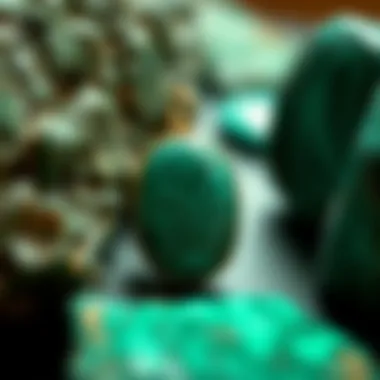
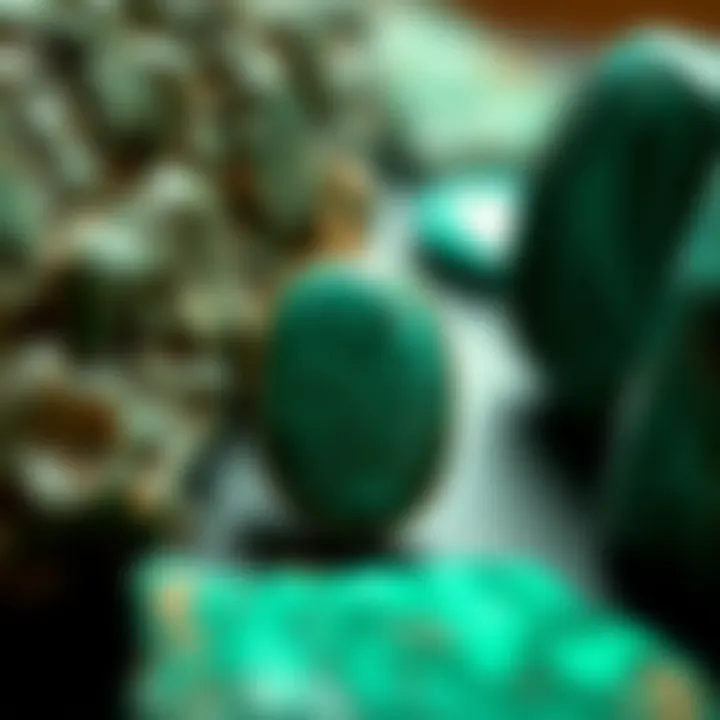
Here's a simplified breakdown of how malachite comes into existence:
- Copper Oxidation: Malachite forms when the copper-bearing minerals, like chalcopyrite or bornite, oxidize in a moisture-rich environment.
- Carbonate Interaction: This oxidation process reacts with bicarbonate in water, leading to the precipitation of malachite.
- Temperature and Pressure Conditions: The specific conditions under which malachite forms can influence its crystal growth and coloration.
The crystal system of malachite is monoclinic, presenting itself in a fibrous or botryoidal habit, which can often be seen exhibiting shiny surfaces. Its hardness rate ranks at 3.5 to 4 on the Mohs scale, making it easy to carve and polish but also somewhat delicate compared to other gemstones. When handling malachite, it’s crucial to keep its soft nature in mind, as it can easily scratch or acquire blemishes if not treated gently.
Global Deposits of Malachite
Malachite reserves can be found in various parts of the globe, revealing both the stone's geological diversity and its historical significance in trade and craftsmanship. Notable deposits exist in:
- Congo: The Democratic Republic of the Congo houses some of the largest and finest malachite specimens. The vast copper reserves here also contribute to the stone's notable patterns and quality.
- Russia: The Ural Mountains are renowned for stunning malachite, historically significant due to its use in royal adornments and architecture.
- Zambia: Known for vibrant shades and attractive formations, Zambian malachite continues to appeal to both collectors and artisans alike.
The uneven distribution of malachite across different continents adds another layer of intrigue, with each location imparting its own characteristics to the stone. Collectors may find varying colors and patterns, reflecting different local mineral compositions and geological conditions.
"Malachite is not merely a stone; it is a geological story that weaves together the earth's history through its transformation and transit across time."
Understanding the geological significance of malachite greatly enhances one's appreciation for this beautiful stone. It allows collectors to recognize not only its aesthetic value but also its roots deep in the earth, where fascinating processes play out over millennia.
Malachite in Art and Jewelry Making
Malachite occupies a special place in the world of art and jewelry making, combining beauty and rich history with unique craftsmanship. Its striking green hues and swirling patterns ensure that each piece of malachite offers an individual character, making it a favorite for artists and artisans alike. Collectors appreciate not just its aesthetic but also its journey from raw stone to polished artifact.
Craftsmanship Techniques
Creating art and jewelry from malachite requires a nuanced approach, as its soft, banded structure demands precision and care. Various techniques come into play, notably:
- Lapidary Techniques: Lapidary workers, those skilled in cutting and polishing stones, play a vital role in transforming rough malachite into exquisite jewelry pieces. This involves cutting the stone into specific shapes and refining its surface through a series of grinding wheels.
- Inlay and Cabochon Setting: One common method is the cabochon cut, where a smooth, rounded surface is created for display purposes. This makes malachite especially popular for pendants, rings, and earrings. Inlays, where malachite is fixed into a recess within a piece, are also popular, adding depth and color.
- Metalworking: Artisans often combine malachite with metals like silver or gold to accentuate its rich greens. Techniques such as soldering, engraving, and setting are used to create stunning, wearable art.
- Mixing Styles: Many craftsmen blend traditional techniques with modern tools such as laser cutting or 3D printing to innovate fresh designs. This fusion of old and new can yield pieces that resonate with various aesthetic preferences.
Each of these techniques offers a pathway for creativity, allowing artisans to express their vision while respecting the intrinsic qualities of malachite.
Design Trends and Styles
The design world surrounding malachite is ever-evolving, influenced by cultural shifts and contemporary aesthetics. Current trends showcase:
- Organic Shapes: Many designers are leaning towards organic, flowing designs that reflect the natural forms found in malachite. Jewelry pieces resembling leaf or flower shapes often find a home in both casual and formal settings.
- Bold Minimalism: Another trend is using malachite in bold, straightforward designs. Chunky rings or statement necklaces with large slabs of malachite appeal to those looking for a striking accessory without excessive embellishments.
- Art Deco Revival: Malachite has a strong association with Art Deco, often characterized by geometric patterns and contrasting colors. Many contemporary artists draw on this style, creating modern pieces that evoke a sense of vintage charm.
- Eco-Friendly Designs: As sustainability becomes more crucial, there's a rising popularity of recycled materials and ethical sources. Jewelers who incorporate malachite with responsibly sourced metals are gaining traction among environmentally-conscious consumers.
Malachite's versatile nature allows it to adapt to trends while remaining a timeless choice, appealing to both new artists and seasoned collectors. Its ability to resonate with various aesthetics keeps its popularity alive in an industry driven by changing tastes and styles.
"Each piece of malachite jewelry tells a story—not just of its geological formation but of the artistry that brought it to life."
For those keen on exploring malachite's place in art and jewelry making, understanding craftsmanship and design trends opens a world where nature and creativity unite.
Etsy as a Marketplace for Malachite
Etsy stands out as an invaluable platform for those seeking unique expressions of malachite stone. It’s more than just an online storefront; it’s a vibrant community where artisans and collectors converge to explore, create, and share. For rock and fossil enthusiasts, Etsy offers a treasure trove of options that reflects the diverse applications and artistry surrounding malachite.
The unique offerings on Etsy allow users to connect directly with makers, providing insights into the production process that traditional retailers may not offer. This direct connection benefits the consumers, as they learn about the craftsmanship behind each piece. For instance, an artisan may share their journey of sourcing malachite from specific deposits or explain their creative inspiration. With such transparency, buyers can make more informed purchases, knowing they’re supporting individual artisans.
Moreover, the charm of Etsy lies in its commitment to handmade and vintage items. This is not merely about selling products; it fosters a culture of creativity, where each piece of malachite, whether crafted into jewelry or home decor, tells its own story.
Understanding Etsy's Platform
Etsy's platform is designed to be user-friendly, making it easier for buyers to navigate through a wide array of malachite products. When you visit the Etsy website, the first thing that catches the eye is the beautifully curated storefronts of various sellers, showcasing dazzling malachite pieces from small artisans around the globe. The platform’s search functionality is robust; potential buyers can explore malachite products simply by typing keywords like “malachite necklace” or “malachite decor.”
Etsy utilizes algorithms that prioritize listings with high customer engagement, so you can often discover the more popular or trendy items. Additionally, many sellers employ descriptive titles and tags to increase the visibility of their items.
Etsy’s system for reviews and ratings is also vital. Buyers can read about others' experiences, making it easier to gauge both product quality and seller reliability. Here, each star rating often makes a world of difference.
Finding Unique Malachite Items
When it comes to uncovering beautiful malachite items on Etsy, it's all about knowing where to look. Consider the following tips when hunting for those standout pieces:
- Use Specific Keywords: Instead of a general term like "malachite," try more detailed phrases like "malachite carved sculpture" or "malachite gemstone bracelet". This helps narrow down results to exactly what you seek.
- Explore Categories: Etsy allows you to browse by category. Whether you’re in the market for jewelry, home decor, or crafts, go through the relevant sections. Each category often unveils hidden gems that might go unnoticed.
- Follow Your Favorites: If you find a seller whose work resonates with you, follow their store. This way, you’ll be notified when they list new items, ensuring you don’t miss out on any truly unique malachite pieces.
Seeking unique malachite items on Etsy isn't just shopping; it’s about discovering stories, passions, and art that resonate on a personal level.
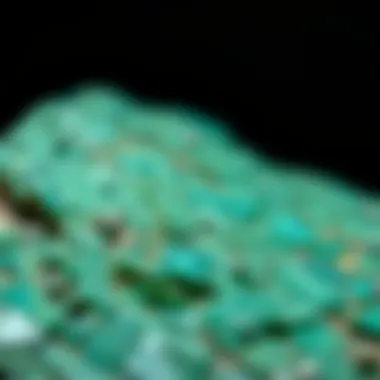
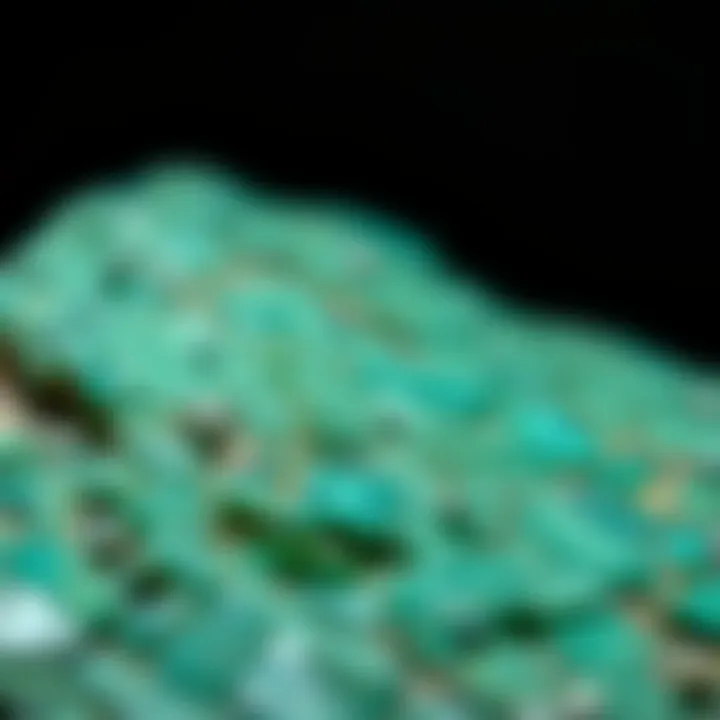
While Etsy is replete with options, discerning buyers should be prepared to invest some time into their search. After all, the beauty of malachite lies not only in its veins and vibrant greens but also in the unique stories and artistry behind each piece.
Evaluating Malachite Products on Etsy
When delving into the vibrant offerings of malachite on Etsy, understanding the nuances of evaluating products becomes essential. Not all malachite is created equal, and the breadth of choices can be both thrilling and overwhelming for collectors and enthusiasts alike. This section aims to shed light on key components that shape the quality and price of malachite artifacts, guiding potential buyers through the intricate process of making informed decisions.
Quality Assessment
Quality assessment of malachite involves several factors that one should take into account. First off, the appearance of the stone is paramount. Genuine malachite flaunts a rich green hue with contrasting lighter and darker bands, showcasing its unique patterns. When browsing listings, it’s wise to scrutinize the images closely; look out for any discrepancies in color and texture that may suggest a less authentic product.
It also pays to check the source of the stone. Trusted sellers often provide information about where the malachite was mined. For instance, Congolese malachite is highly sought after due to its superior quality. Additionally, discerning buyers should consider whether the piece has been treated or enhanced in any way. A seller that’s transparent about their products’ origins and procedures builds trust. If available, opt for those listings that include certificates of authenticity or provenance.
Beyond visual quality, the craftsmanship of the finished piece is also crucial. Well-made jewelry or art should feel substantial without being heavy and should show attention to detail. From the polishing of the stone to the settings used in jewelry, every little detail matters. Don't hesitate to ask sellers for clarifications on their craftsmanship processes, if needed.
"Quality malachite holds natural beauty that tells a story of the earth's artistry."
Price Range Analysis
Price is another significant element that merits attention when evaluating malachite products on Etsy. Typically, prices can range widely, influenced by factors such as size, quality, and design intricacies. On average, you might find smaller malachite pieces, like pendants, ranging from fifteen to fifty dollars. However, larger, more intricate works—like carved sculptures—may soar into the hundreds or even thousands of dollars.
To help gauge what a fair price looks like, consider comparing similar items across different sellers. This habit creates a clearer picture of market trends. It should be noted that extraordinarily low prices can often be a red flag, suggesting potential fakes or low-quality stones. Thus, balancing quality with price is essential for a solid purchase decision.
Why not create a list of factors affecting pricing? Some elements include:
- Size and Weight: Larger stones typically command higher prices.
- Origin: Rarer sources may drive costs up due to limited availability.
- Condition and Treatment: Enhanced stones may be sold at a premium.
- Craftsmanship: Artisan pieces that show remarkable skill will also be valued more.
Being aware of these subtleties in pricing can empower you as a buyer. Knowledge is power in the world of collectibles, and with a keen eye, each purchase can lead to delightful finds that resonate with your aesthetic and investment value.
Caring for Malachite
Caring for malachite is not just a matter of maintenance; it’s about preserving the natural beauty and unique character of this fascinating stone. Whether you own a stunning malachite pendant or an intricately designed malachite sculpture, understanding how to properly care for these pieces ensures their longevity and vibrancy. Malachite is a soft mineral, primarily composed of copper carbonate. Because of its relatively low hardness on the Mohs scale, it can be quite susceptible to scratches and damage if not treated with the proper precautions.
A delicate touch goes a long way with malachite. The benefits of careful cleaning and maintenance are twofold: you safeguard the visual appeal of your pieces while also protecting any potential investment value that may come with high-quality malachite artifacts. Thus, knowing how to clean, maintain, and store your malachite effectively is imperative for any collector or artisan.
Cleaning and Maintenance
When it comes to cleaning malachite, the golden rule is simplicity. Here are some important notes to consider when maintaining your malachite pieces:
- Avoid Harsh Chemicals: Many household cleaning products contain abrasives that can scratch or stain malachite. Always steer clear of ammonia, bleach, or vinegar, as these substances can dull or damage the surface.
- Use a Soft Cloth: To clean your malachite item, use a soft, damp cloth. Gently wipe away dirt, dust, and fingerprints. A microfiber cloth works particularly well due to its non-scratchy texture.
- Temperature Sensitivity: Keep malachite away from extreme temperature changes. Rapid temperature changes can cause the stone to crack or become discolored.
- Avoid Direct Sunlight: Prolonged exposure to the sun can fade the color and affect the luster of the stone. It's best to keep your pieces out of direct sunlight.
"Investing in proper care for your malachite can mean the difference between a stunning piece and a worn-out relic."
Establishing a regular cleaning routine, perhaps once every few months, will go a long way in preserving the visual splendor and durability of your malachite artifacts.
Storage Recommendations
Proper storage is just as crucial as cleaning. Malachite should ideally be stored in a manner that prevents scratches and other damages. Here are a few tips for storing your malachite items safely:
- Use Soft Pouches: Place each malachite item in a soft pouch, preferably made of cloth. This prevents any physical contact with harder surfaces and other objects that can scratch the stone.
- Avoid Stacking: If you have multiple malachite pieces, refrain from stacking them on top of one another. Instead, store them in separate compartments or boxes to minimize friction.
- Keep Away from Other Gems: Different stones have varying hardness levels. Keeping malachite stored away from harder stones like diamonds or sapphires can reduce the likelihood of scratches.
- Environment Matters: Store malachite in a reasonably humidity-controlled environment. Too much moisture can lead to the growth of mold, while excessive dryness can cause cracks.
The Symbolism of Malachite
Malachite is not just an attractive stone with its rich green swirls and patterns; it carries a myriad of meanings across different cultures. For many, it represents transformation and growth. This deep-seated symbolism reflects the natural processes of the earth, where malachite forms over thousands of years, reminding us of the beauty of patience and evolution.
Cultural beliefs often intertwine with perceptions of malachite, making it more than just a pretty piece to display. From the ancient Egyptians to modern artisans, malachite has been etched into the fabric of history, representing wealth, power, and protection against negative forces. This cultural richness adds layered meanings for collectors and enthusiasts alike.
"In the hands of the artist or collector, malachite becomes a vessel of history, a conduit of meaning that transcends its material existence."
Cultural Perspectives
In various cultures, malachite has played significant roles. In ancient Egypt, it was used for jewelry and adornments. They believed it to be a stone of protection, especially for children, often incorporating it into amulets to safeguard against harm. Egyptians also believed that malachite had the power to ward off evil spirits, making it a popular choice for burying alongside mummies and pharaohs.
In Africa, malachite is often viewed as a stone symbolizing fertility and growth. Tribes sometimes use it in rituals meant to ensure bountiful harvests or the health of future generations. This shows how malachite's green color, reminiscent of lush landscapes, links to life and prosperity.
Additionally, Russian artisans have crafted malachite into stunning works of art for centuries. Its rich history within Russian culture often ties back to royalty, where malachite was extensively used in palaces and decorative arts. This lends an air of sophistication and grandeur to any malachite product.
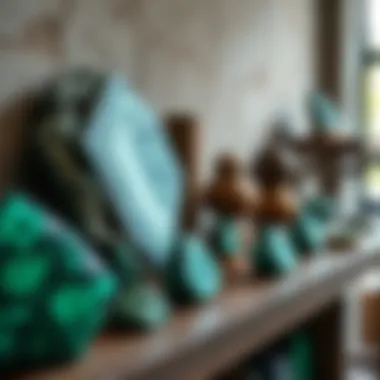
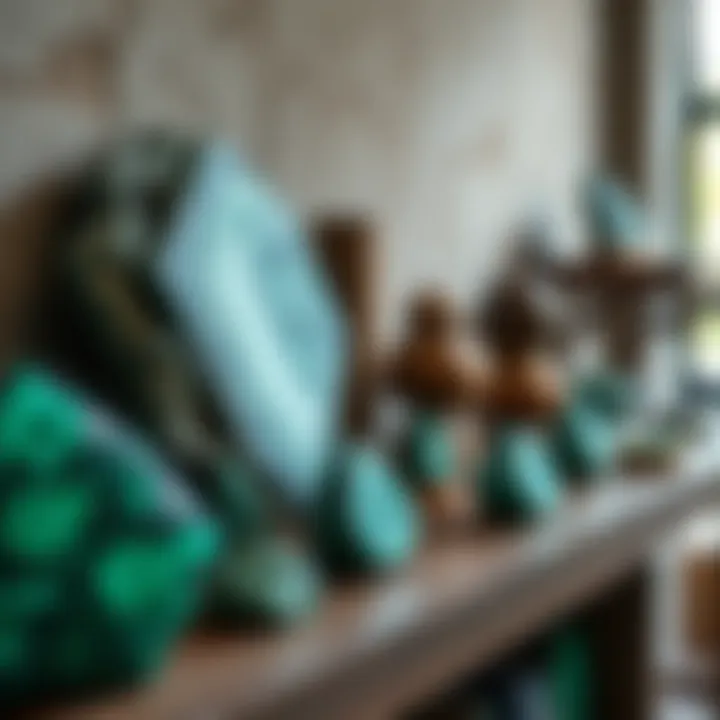
Spiritual Beliefs and Uses
Malachite has found its place in spiritual practices as a powerful healing stone. Many believe it facilitates emotional balance and healing, helping individuals overcome traumas and embrace change. Its association with the heart chakra underscores its purported ability to encourage love, compassion, and emotional well-being.
Many practitioners of crystal healing often recommend using malachite during meditation. The stone is thought to enhance one’s connection with nature and the earth. When held or worn close to the body, believers suggest it can absorb negative energies, allowing positive vibrations to flow freely. This is one reason why collectors might seek malachite pieces not just for their aesthetic value but also for their perceived power.
Moreover, crafting artifacts from malachite encourages a deeper connection to the earth. Those who dabble in making their creations take part in a tradition that's as enriching as the colors are captivating. The process is seen as an expression of creativity infused with the stone's transformative energies, making every piece unique in both form and function.
Crafting Your Own Malachite Artifacts
Creating your own malachite artifacts can be a rewarding endeavor that merges artistic expression with a connection to nature. This section highlights the significance of this craft, considering its benefits and factors to keep in mind. Craftsmanship offers not only a sense of accomplishment but also the opportunity to personalize your collection with unique pieces that reflect your taste.
When you craft with malachite, you engage deeply with the material that has captivated artists and collectors for centuries. The brilliant green swirls and patterns in malachite lend themselves beautifully to artistic designs. Whether you aim to make jewelry, decorative items, or small sculptures, each piece you create can embody your personal style.
Delving into crafting can also enhance your appreciation of malachite itself. Understanding its properties and characteristics can lead to more effective techniques and outcomes.
Benefits of Crafting with Malachite
- Personal Satisfaction: There's a unique joy in creating something by hand, especially from a stone as storied as malachite.
- Unique Artifacts: You won't find your creation on someone else’s shelf. Each crafted piece is distinctly yours.
- Creative Outlets: This activity serves as a fantastic way to express creativity, allowing you to explore various designs and forms.
Tools and Materials Required
When stepping into the world of malachite crafting, having the right tools and materials is crucial for both safety and effectiveness. Below is a rundown of what you’ll need to kick off your crafting journey:
- Malachite Stone: Sourced from trustworthy vendors. Ensure the quality is high to achieve the best results in your artifacts.
- Chisels and Files: Essential for shaping and smoothing the stone. Look for those designed for stonework.
- Protective Gear: Always prioritize safety. Gloves and goggles can protect from shards and dust.
- Saws: A wet saw can help in making precise cuts without damaging the delicate structure of malachite.
- Polishing Pads: These are crucial for giving your pieces that glossy finish. Select various grits for different stages of smoothing.
You might consider using a diamond-tipped rotary tool for finer details, especially for intricate jewelry making.
Steps for Beginners
For those new to crafting with malachite, here’s a simple guide to get you on the right path.
- Select Your Stone: Start by choosing a piece of malachite that inspires you. Look for unique patterns and colors.
- Sketch Your Design: Before you dive into working with the stone, sketch out what you want to create. This blueprint will guide your process.
- Safety First: Ensure you're wearing protective gear. Safety is paramount, especially when using tools.
- Cut and Shape: Begin by using the saw to make the initial cuts. Gradually refine the shape using chisels and files until you reach your desired form.
- Smooth the Edges: Progress through your polishing pads to smooth the surface of your artifact. Be patient; this step can take some time but yields beautiful results.
- Finish Your Piece: After polishing, you may want to apply a sealant to enhance the shine and protect your creation.
Crafting is not just about the end product; it’s about the journey and the stories we create along the way.
Starting with small projects can steadily build your skills and confidence in this unique craft. And as you progress, you might find yourself wanting to create larger or more complex pieces, deepening your connection to malachite and its rich beauty. So, gather your tools, and get started on your malachite crafting adventure!
Connecting with the Malachite Community
Diving into the realm of malachite can feel like stepping into a vibrant world full of hues and artistic possibilities. But, beyond the stunning visuals and intricate designs lies a thriving community that shares a passion for this captivating stone. Connecting with fellow enthusiasts, collectors, and artisans can deepen one’s appreciation for malachite and foster a sense of belonging. This section explores the importance of engaging with the malachite community, offering insights into where to find it and the benefits of connecting with others who share this interest.
Social Media and Networking
In today’s digital age, social media serves as a powerful tool for joining like-minded individuals. Platforms like Instagram, Pinterest, and Facebook host vibrant communities dedicated to malachite and other gemstones. By following hashtags such as #MalachiteLovers or #MalachiteArt, one can discover countless photos, tutorials, and stories shared by artists and collectors alike.
- Instagram offers a visual feast. Many artists showcase their latest creations, allowing collectors to see what’s trending in malachite jewelry or home decor.
- Facebook not only has groups aimed at sharing knowledge about stone care and artistry techniques but also provides a platform for buying, selling, and trading pieces. Joining these groups opens doors to discussions about the best practices in conserving malachite and where to source high-quality materials.
- Pinterest can be an excellent resource for inspiration. Browsing through malachite pins may lead to discovering unique ways to incorporate this stone into various art forms, from abstract paintings to wearable art.
Overall, by engaging on these platforms, enthusiasts can gather tips, share experiences, and stay informed about the latest trends in malachite art.
Forums and Groups Focused on Malachite
Beyond social media, specific online forums and groups are dedicated to discussing malachite and its many facets. These platforms offer a space where one can dive deep into conversations about the geological aspects of malachite, as well as its artistic applications.
- Websites like Reddit host communities such as r/mineralcollectors or r/crystals, where knowledgeable individuals often share insights about collecting malachite, its historical significance, and practical cutting techniques.
- Additionally, engaging in specialized forums allows members to ask specific questions, share their own findings, or even seek advice on maintaining their malachite pieces. The information shared here often comes from seasoned collectors and artists who are eager to pass on their knowledge.
- Joining local gem and mineral clubs can also provide an opportunity for in-person networking. Many of these clubs organize events where members can exchange stones, discuss best practices in care, and even collaborate on projects.
Connecting with the malachite community, whether through social media or specialized forums, not only broadens one’s understanding but also enhances one’s journey as a collector or artisan. As the saying goes, "Two heads are better than one"; sharing knowledge makes for a richer experience in exploring malachite.
End: The Everlasting Appeal of Malachite
In wrapping up our exploration of malachite, it’s essential to reflect on what makes this stone resonate so deeply with collectors and artisans alike. The allure of malachite lies not only in its striking green hues and unique patterns but also in the stories it carries through history and culture. This stone has journeyed from ancient civilizations—who prized it for its beauty and believed it to possess protective qualities—into the modern realm of art and jewelry. Each piece holds a narrative, shaped by both its geological origins and the hands that crafted it.
Final Thoughts on Collection and Craft
Collecting malachite is more than just an aesthetic pursuit; it’s about appreciating the craftsmanship and the effort that goes into each handmade item. When you browse through listings on Etsy, you encounter an array of creations that span from simple polished stones to intricate jewelry pieces. Here are some thoughts to keep in mind:
- Quality Matters: Be sure to evaluate the craftsmanship. Look for details in the finish, as well as authenticity in the stone. Genuine malachite will showcase the characteristic banding and vivid color.
- Cultural Significance: There's a richness to owning malachite that links you to ancient traditions. Each piece may come with its own story, reflecting the cultural importance that malachite held in various societies.
- Investment Potential: Not only is malachite beautiful, it can also be a wise addition to your collection, especially as demand grows for unique artisanal pieces.
To truly appreciate malachite, consider ways to enhance your collection beyond mere ownership. Engage with fellow collectors or become part of communities focused on this captivating stone. Online platforms, forums, and even local collectors’ clubs can provide insights, tips, and stories that add depth to your appreciation.
"Art is not what you see, but what you make others see." – Edgar Degas
As you explore the world of malachite, remember that each piece is an entry point into a broader narrative—one that ties together the earth’s geological story, human creativity, and historical significance.



